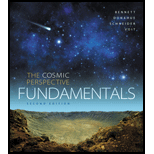
Concept explainers
The object which has the smallest radius.
Answer to Problem 1QQ
The white dwarf with
Explanation of Solution
Introduction:
When a low mass star reaches the end of its lifetime, it sheds its outer layers in the form of nebula. Its core stands exposed and this exposed core of the star is called the white dwarf.
A white dwarf has a very large gravity at its surface because they have masses equal to stars but a very small size. The star is kept in equilibrium due to a counter pressure called the electron degeneracy pressure, when the inward pressure due to gravity is countered by the outward degeneracy pressure.
It is found that the more the mass of the white dwarf, smaller is its size. This is because the large mass results in greater gravitational forces, which compress the star to a greater extent.
A white dwarf of mass equal to
Thus, option a is correct and b is incorrect.
Jupiter is the largest planet in the solar system with a radius of about 11.2 times the Earth radius, making it the largest of the given objects.
Thus, option c is incorrect.
Conclusion:
Of the objects-(a) 1.2
Want to see more full solutions like this?
Chapter 10 Solutions
The Cosmic Perspective Fundamentals (2nd Edition)
- What is the size of a typical white dwarf? Group of answer choices 1.0 solar radii 0.5 solar radii 0.1 solar radii (roughly the size of Jupiter) 0.01 solar radii (roughly the size of Earth) 5 solar radiiarrow_forwardThe orbit of the binary pulsar PSR 1936+16, studied by Taylor and Hulse, a. is so small that the orbital period is smaller than the pulsar period. b. is growing smaller, presumably by emitting gravitational waves. c. provides evidence that it is being orbited by at least 6 planets the size of Jupiter. d. shows large changes each time an X ray burst is emitted from the system. e. contains a white dwarf and a black hole.arrow_forwardThe Sun's mass is 2.0x1030 kg, its radius is 7.0x105 km, and it has a rotational period of approximately 28 days. If the Sun should collapse into a white dwarf of radius 3.7x103 km, what would its period be if no mass were ejected and a sphere of uniform density can model the Sun both before and after? 60.40 s Incorrect. Tries 10/10 Previous Triesarrow_forward
- Arrange the following stars in order of their evolution: A. A star with no nuclear reactions going on in the core, which is made primarily of carbon and oxygen. B. A star of uniform composition from center to surface; it contains hydrogen but has no nuclear reactions going on in the core. C. A star that is fusing hydrogen to form helium in its core. D. A star that is fusing helium to carbon in the core and hydrogen to helium in a shell around the core. E. A star that has no nuclear reactions going on in the core but is fusing hydrogen to form helium in a shell around the core.arrow_forwardHow much would you weigh if you were suddenly transported to the white dwarf Sirius B? You may use your own weight (or if don’t want to own up to what it is, assume you weigh 70 kg or 150 lb). In this case, assume that the companion to Sirius has a mass equal to that of the Sun and a radius equal to that of Earth. Remember Newton’s law of gravity: F=GM1M2/R2 and that your weight is proportional to the force that you feel. What kind of star should you travel to if you want to lose weight (and not gain it)?arrow_forwardLook elsewhere in this book for necessary data, and indicate what the final stage of evolution-white dwarf, neutron star, or black hole-will be for each of these kinds of stars. A. Spectral type-O main-sequence star B. Spectral type-B main-sequence star C. Spectral type-A main-sequence star D. Spectral type-G main-sequence star E. Spectral type-M main-sequence stararrow_forward
- Plasketts binary system consists of two stars that revolve in a circular orbit about a center of mass midway between them. This statement implies that the masses of the two stars are equal (Fig. P11.19). Assume the orbital speed of each star is |v|=220km/s and the orbital period of each is 14.4 days. Find the mass M of each star. (For comparison, the mass of our Sun is 1.99 1030 kg.)arrow_forwardA Type Ia Supernova is an example of a: a. Parallax object b. Moving cluster object c. Standard ruler object d. Standard candle objectarrow_forwardUse the H-R Diagram below to help answer the following questions. Luminosity (solar units) 10,000+ 1,000+ 100+ 10- .01+ .001+ .0001 B White Dwarfs 20,000 B Spectral Type A Main Sequence D 10,000 Temperature (K) FGK Red Giants 5,000 M -5 10 15 Absolute Magnitudearrow_forward
 Foundations of Astronomy (MindTap Course List)PhysicsISBN:9781337399920Author:Michael A. Seeds, Dana BackmanPublisher:Cengage Learning
Foundations of Astronomy (MindTap Course List)PhysicsISBN:9781337399920Author:Michael A. Seeds, Dana BackmanPublisher:Cengage Learning Stars and Galaxies (MindTap Course List)PhysicsISBN:9781337399944Author:Michael A. SeedsPublisher:Cengage Learning
Stars and Galaxies (MindTap Course List)PhysicsISBN:9781337399944Author:Michael A. SeedsPublisher:Cengage Learning Stars and GalaxiesPhysicsISBN:9781305120785Author:Michael A. Seeds, Dana BackmanPublisher:Cengage Learning
Stars and GalaxiesPhysicsISBN:9781305120785Author:Michael A. Seeds, Dana BackmanPublisher:Cengage Learning An Introduction to Physical SciencePhysicsISBN:9781305079137Author:James Shipman, Jerry D. Wilson, Charles A. Higgins, Omar TorresPublisher:Cengage Learning
An Introduction to Physical SciencePhysicsISBN:9781305079137Author:James Shipman, Jerry D. Wilson, Charles A. Higgins, Omar TorresPublisher:Cengage Learning Horizons: Exploring the Universe (MindTap Course ...PhysicsISBN:9781305960961Author:Michael A. Seeds, Dana BackmanPublisher:Cengage Learning
Horizons: Exploring the Universe (MindTap Course ...PhysicsISBN:9781305960961Author:Michael A. Seeds, Dana BackmanPublisher:Cengage Learning Principles of Physics: A Calculus-Based TextPhysicsISBN:9781133104261Author:Raymond A. Serway, John W. JewettPublisher:Cengage Learning
Principles of Physics: A Calculus-Based TextPhysicsISBN:9781133104261Author:Raymond A. Serway, John W. JewettPublisher:Cengage Learning





